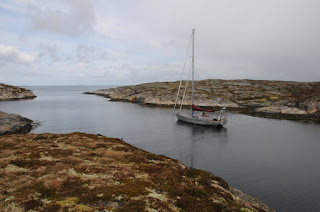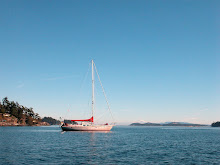
Our first anchorage Gashamma, in Hornsund fjord, with its beach scattered with remnants of Svalbard’s past, turned out to be an excellent introduction to the area. On one side are the remains of a prosperous 17th century whaling camp. Very little of the actual camp remains aside from a few bits of wood but the whale bones surrounding the site make it easy to envision the extensive whaling that went on in the vicinity.
The Russo-Swedish scientific expedition huts on the other side of the beach are in much better shape. They are dated from 1899-1901 but must have been used until fairly recently as many of the remnants including the axe and kettle are fairly modern.
The area around the huts was one of the few place where the snow had already thawed, providing excellent grazing potential for a shy reindeer that briefly posed for photos before leaping into the air like a ballerina and taking off for higher ground. It was a powerful and elegant display from a creature with such short legs. Unlike normal reindeer, Svalbard Reindeer are smaller and have a much thicker pelt that enables them to survive in temperatures down to -50 C.
Aside from the historical ruins and wildlife, the most intriguing experience on shore was walking on the candle ice covered ground. Once stepped on candle ice instantly shatters into individual icicles giving it a domino like effect. At first it is quite disconcerting to walk on but after a few tentative steps it becomes obvious that you will only sink in a few inches.
The head of Hornsund was still solid with sea ice but we were able to invent an anchorage near Chomjakovbreen, one of the tidewater glaciers midway up the fjord. Chomjakovbreen is magnificent and the surrounding mountains made the location look ideal for a hike. Once Frances, Kirsty, Elvar and Eivan got to shore they quickly realized that the snow was covered with Polar Bear tracks. The tracks ranged from old, fairly recent to very fresh and it did not take them long to radio back to the boat and request to be retrieved. Krystina had stayed on board hoping to enjoy a quiet afternoon but was content with picking up the potential Polar Bear treats and taking them for a dinghy tour of the glacier instead.
Our last stop in Hornsund was the Polish Research Station which is manned year around. The staff warmly invited us inside, supplied us with coffee and delicious polish cakes followed by a tour of their station. From the tour we learned that they do some monitoring for the Norwegian Polar Institute but mostly they do their own research. They also explained why Hornsund is so popular amongst Polar Bears. During the winter the bears live on the sea ice which breaks up and floats around to the west cost of Spitsbergen. The bears use Hornsund Fjord to return to the east side. This year 98 bears have already passed their station and they are hoping to reach 100. Before we leave Svalbard we hope to have time to stop by the Polish Research Station and repay them for their wonderful hospitality.
For more photos of Hornsund Fjord
http://picasaweb.google.com/krystinascheller/HornsundFjord#







